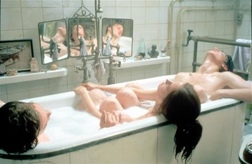Libertine
Four tangos for string sextet (2011-2012)
Dedicated to the memory of Oscar Figueroa.
For two violins, two violas and two cellos.
Commissioned by Musik i Uppland.
Duration: 37 minutes (8'+8'+16'+5')
I. Delirium
II. Viejo verde
III. Nostalgia (Neurosis)
IV. Epitaph
Performed by the Uppsala Chamber Soloists:
Klara Hellgren, violin I
Nil-Erik Sparf, violin II
Susanne Magnusson, viola I
Bernt Lysell, viola II
Erik Wahlgren, cello I
Elemér Lavotha, cello II
Live concert recording from the 28th April 2012.
Score
Score and parts are published by the Swedish Music Information Centre.
Commentary
This piece was commissioned by Musik i Uppland. It is a kind of tango suite - but while composing it, I digressed so far away from conventional tango, or even from ‘tango nuevo’, forms, that I was actually rather hesitant about what to call it.
Libertine is written in memory of Oscar Figueroa, a flamboyant Argentine director of opera who emigrated to Sweden in 1980. He was a very dear friend of mine. A couple of years ago, at the age of 75, he decided to end his own life. He was very passionate about his work, but, even more, he was a true libertine, in the most profound sense of the word, throughout his life. Each of the four tangos represents a different aspect of him - or rather my perception of him - and his energetic, devoted, drastic, dark and humorous personality pours out into the music.
The piece comprises four movements, symphonically constructed and of considerable length.
In the first movement, ‘Delirium’, structurally the symphonic opening, a stormy, delirious tango-theme is contrasted with an unworldly ecstatic stillness.
The second movement, which is really the scherzo, is entitled ‘Viejo Verde’, which is a Spanish euphemism for ‘dirty old man’ (literally, ‘old green’). It starts off with a slow, luxurious tango, followed by a humorous episode, containing fast Argentine dances such as Milonga and Candombe, after which the slower theme returns blissfully.
The third and longest movement, the symphonic adagio of the piece, ‘Nostalgia (Neurosis)’, is a dark, moody and tenebrous piece of music. After a violently rising opening, the viola starts a sorrowful and bitter cantilena, which is continued by the cello and driven to its climax. After this, shadows of antique tango styles take over, contrasted with reminiscences of the movement's violent opening mood. All this is eventually discharged in a long, muted and somewhat indifferent epilogue.
The fourth movement, ‘Epitaph’, is the fast finale, a violently rhythmic, bitter-sweet and fast-paced tango, that concludes the suite.
The piece was premiered in 2012 by the Uppsala Chamber Soloists, a spectacular ensemble, in which all the members are virtuosos in their own right, as well as great chamber musicians. They have performed the work many times already.
Libertine is written in memory of Oscar Figueroa, a flamboyant Argentine director of opera who emigrated to Sweden in 1980. He was a very dear friend of mine. A couple of years ago, at the age of 75, he decided to end his own life. He was very passionate about his work, but, even more, he was a true libertine, in the most profound sense of the word, throughout his life. Each of the four tangos represents a different aspect of him - or rather my perception of him - and his energetic, devoted, drastic, dark and humorous personality pours out into the music.
The piece comprises four movements, symphonically constructed and of considerable length.
In the first movement, ‘Delirium’, structurally the symphonic opening, a stormy, delirious tango-theme is contrasted with an unworldly ecstatic stillness.
The second movement, which is really the scherzo, is entitled ‘Viejo Verde’, which is a Spanish euphemism for ‘dirty old man’ (literally, ‘old green’). It starts off with a slow, luxurious tango, followed by a humorous episode, containing fast Argentine dances such as Milonga and Candombe, after which the slower theme returns blissfully.
The third and longest movement, the symphonic adagio of the piece, ‘Nostalgia (Neurosis)’, is a dark, moody and tenebrous piece of music. After a violently rising opening, the viola starts a sorrowful and bitter cantilena, which is continued by the cello and driven to its climax. After this, shadows of antique tango styles take over, contrasted with reminiscences of the movement's violent opening mood. All this is eventually discharged in a long, muted and somewhat indifferent epilogue.
The fourth movement, ‘Epitaph’, is the fast finale, a violently rhythmic, bitter-sweet and fast-paced tango, that concludes the suite.
The piece was premiered in 2012 by the Uppsala Chamber Soloists, a spectacular ensemble, in which all the members are virtuosos in their own right, as well as great chamber musicians. They have performed the work many times already.




